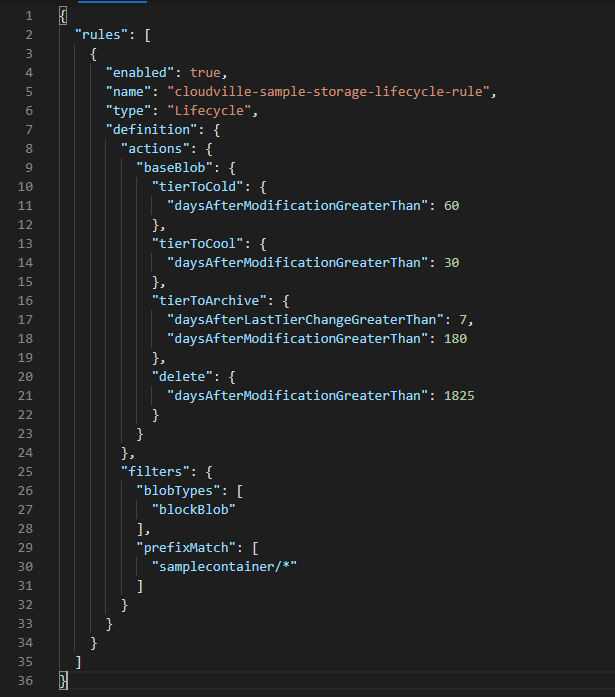AZ-104: Azure Blob Storage
 Cloudville
CloudvilleAzure Blob Storage is Microsoft's cloud-based object storage solution, optimised for storing vast amounts of unstructured data. Unlike traditional file systems that use a directory tree, Blob Storage uses a flat namespace, making data access and management simpler and more scalable. The primary components of Blob Storage are:
Containers: These are similar to folders in a traditional file system. They provide a grouping of a set of blobs, and all blobs must be in a container.
Blobs: These are the individual data elements or files stored in Azure Blob Storage. They can range from text files, images, videos, backups, and more.
Blob Types
Azure Blob Storage supports three primary blob types, each designed for specific use cases:
Block Blobs
Optimised for streaming and storing cloud-native applications' data. They can handle up to about 4.7 TB of data and are ideal for storing text or binary data, such as documents, media files, or application installers. Here the data is static and rarely changes.
Append Blobs
These are similar to block blobs but optimised for append operations. They're perfect for scenarios where the data is mostly static but experiences frequent incremental changes. For example, logging data from virtual machines.
Page Blobs
Designed for frequent random read/write operations. They are used as the OS and data disks for Azure Virtual Machines and can be up to 8 TB in size.
Blob Access Tiers
Azure Blob Storage provides different access tiers to optimise storage costs based on data access patterns:
Hot Tier: For frequently accessed data.
Cool Tier: For infrequently accessed data that will remain stored for at least 30 days.
Cold Tier: For infrequently accessed data that you want to keep for at least another 90 days
Archive Tier: For data that will remain untouched for extended periods and can tolerate retrieval latencies (between 10 - 15 hours sometimes)
It's essential to choose the right access tier based on your data's lifecycle to optimise costs. For instance, data that's frequently accessed initially but becomes less accessed over time can start in the hot tier and then be transitioned to the cool or archive tiers as its access pattern changes. The move between tiers can be automated by making use of blob lifecycle management policies.
Lifecycle Management
Azure Blob Storage offers lifecycle management policies that automate tasks like transitioning blobs to cooler storage tiers and deleting blobs at the end of their lifecycle. By defining rules in these policies, you can move blobs between the hot, cool, cold and archive tiers, or even delete blobs that are past a specified age. This is particularly useful for optimising costs and ensuring that data is stored in the most cost-effective manner based on its access patterns and age. All without manual intervention.
Lifecycle Management Policy Definition
A lifecycle management policy is defined using a JSON document that contains a collection of rules. Each rule within the policy specifies the conditions under which certain actions (like transitioning to a different tier or deleting the blob) should be taken.
Here's a sample policy below:

Explanation
The JSON in the image defines an Azure Blob Storage lifecycle management rule named cloudville-sample-storage-lifecycle-rule. It helps optimize storage costs by automatically transitioning or deleting blobs based on their age or activity:
After 30 days, blobs are moved to the Cool tier.
After 60 days, they are promoted to the Cold tier.
After 180 days of no modification and at least 7 days since the last tier change, blobs move to the Archive tier.
After 5 years (1825 days), the blobs are automatically deleted.
This rule applies only to block blobs within the samplecontainer/ path. Such automation ensures that infrequently accessed data is stored cost-effectively while maintaining data lifecycle hygiene.
NOTE: “The platform runs the lifecycle policy once a day. Once you configure or edit a policy, it can take up to 24 hours for changes to go into effect. Once the policy is in effect, it could take up to 24 hours for some actions to run. Therefore, the policy actions may take up to 48 hours to complete.
If you disable a policy, then no new policy runs will be scheduled, but if a run is already in progress, that run will continue until it completes.”
Uses of Blob Storage
Azure Blob Storage is not just for storing data; it has other numerous uses which include:
Static Website Hosting: Azure Blob Storage can be used to host static websites. This is particularly useful for sites that don't require server-side processing. The static website feature allows you to serve static content directly from the blob container without the need for a separate web server.
Content Delivery Networks (CDN): Blob Storage can be integrated with Azure CDN to deliver large amounts of content to users with high-bandwidth and low-latency. This is especially useful for delivering multimedia content, software patches, and other large files to a global audience.
Data Archiving and Backup: Given its scalability and cost-effectiveness, Blob Storage is an ideal solution for archiving data that doesn't need to be accessed frequently. With the lifecycle management feature, older data can be automatically moved to cooler storage tiers, optimising costs.
Big Data Analytics: Blob Storage can be used to store large datasets that can be processed using Azure HDInsight or other big data processing solutions.
Media Streaming: Store and stream audio and video content directly from Blob Storage.
Disaster Recovery: Use Blob Storage as a backup solution to ensure data availability in case of system failures or other unforeseen events.
Conclusion
Azure Blob Storage is a cornerstone of cloud-based application development and infrastructure, offering scalable, secure, and cost-effective storage for virtually any data type. Whether you're storing images, logs, backups, or large datasets for analytics, Blob Storage provides the flexibility and performance to meet your needs.
Understanding the different blob types, access tiers, redundancy options, and lifecycle management (like the sample rule we walked through) not only helps you ace the AZ-104 exam, but also equips you to design smarter, more efficient solutions in real-world projects.
REFERENCE:
Subscribe to my newsletter
Read articles from Cloudville directly inside your inbox. Subscribe to the newsletter, and don't miss out.
Written by
